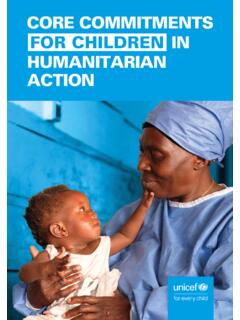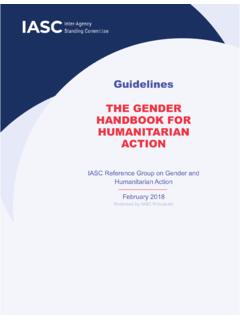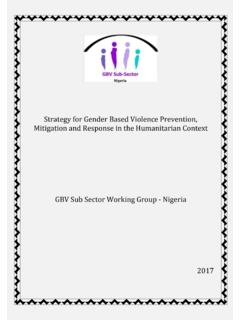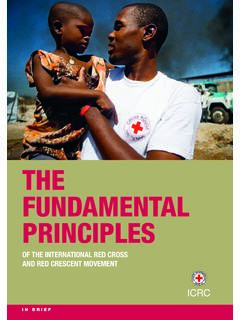Transcription of Humanitarian principles and international humanitarian ...
1 Humanitarian principles and international Humanitarian coordination mechanisms012 Contents Chapter 1 Humanitarian principles and international Humanitarian coordination mechanisms Introduction Humanitarian principles Key Humanitarian issues When to engage? Humanitarian emergencies and public health events Humanitarian coordination Global Health Cluster WHO responsibilities as Global Health Cluster lead agency Global Health Cluster vision and mission Guiding principles of the Global Health Cluster Humanitarian reform, the Transformative Agenda and new ways of working Humanitarian reform Transformative Agenda The triple nexus of Humanitarian , development and peacebuilding actors Centrality of protection in Humanitarian action What is protection mainstreaming?
2 Health: tips for protection mainstreaming Protection from sexual exploitation and abuse Accountability to affected populations What is accountability to affected populations? Incorporating accountability to affected populations into the health cluster response at country level What is the link between accountability to affected populations and protection? Mainstreaming a comprehensive people-centred approach in the health response 26 References 27 Endnotes 30 Boxes Box Humanitarian Programme Cycle 12 Box Gender-based violence 26 Figures Figure The cluster approach.
3 Clusters and lead agencies 9 Figure Humanitarian Programme Cycle in protracted emergencies 11 Tables Table Humanitarian principles and their underlying concepts 3 Table Criteria considered for initiating a scale-up activation 14 Abbreviations CHS Core Humanitarian Standard on Quality and AccountabilityFAO Food and Agriculture Organization of the United NationsIASC Inter-Agency Standing CommitteeIHR international Health Regulations NGO nongovernmental organizationOCHA United Nations Office for the Coordination of Humanitarian AffairsOIE World Organisation for Animal HealthSDG Sustainable Development GoalUNICEF United Nations Children s FundWHO World Health principles and international Humanitarian coordination mechanisms principles and international Humanitarian coordination mechanisms suffering must be addressed wherever it is found.
4 The purpose of Humanitarian action is to protect life and health and ensure respect for human actors must not take sides in hostilities or engage in controversies of a political, racial, religious or ideological action must be carried out based on need alone, giving priority to the most urgent cases of distress and making no distinctions based on nationality, race, gender, religious belief, class or political action must be autonomous from the political, economic, military or other objectives that any actor may hold about areas where Humanitarian action is being Humanitarian principles and international Humanitarian coordination mechanisms Introduction This chapter provides a summary of how Humanitarian action has evolved in recent decades.
5 It includes an overview of Humanitarian principles and other key global initiatives that have helped shape Humanitarian coordination. For additional information, refer to the Humanitarian response and Inter-Agency Standing Committee (IASC) Humanitarian principles Four Humanitarian principles humanity, neutrality, impartiality and independence provide the fundamental foundations for Humanitarian action and are central to establishing and maintaining access to affected populations, whether in the context of a natural disaster, an armed conflict or a complex emergency.
6 Table presents the underlying concepts on which those principles are based. Table Humanitarian principles and their underlying conceptsNote: The first three Humanitarian principles were endorsed in United Nations General Assembly resolution 46/182 of 1991, known as the Humanitarian response resolution . The fourth principle (independence) was endorsed in 2004 under resolution 58 principles and international Humanitarian coordination mechanisms principles and international Humanitarian coordination mechanisms compliance with Humanitarian principles in Humanitarian response is an essential element of effective Humanitarian coordination.
7 United Nations agencies are mandated to embrace all four of these principles . Commitment to the four Humanitarian principles is expressed at institutional level by the majority of international Humanitarian organizations. Furthermore, globally over 450 organizations are signatory to the Code of Conduct for the international Red Cross and Red Crescent Movement and Non-Governmental Organizations (NGOs) in Disaster Relief, which includes a commitment to adhere to these Humanitarian principles (1). Key Humanitarian When to engage? international Humanitarian law in all types of armed conflict whether international or non- international imposes obligations on the warring parties to use their best efforts to collect and care for the wounded and sick (2, 3).
8 3 This means either that the parties to armed conflicts perform these medical activities themselves, traditionally through their military medical corps, or, where they are unable or unwilling to do so, that they permit others, such as the local civilian administration or impartial Humanitarian organizations, to assist them. In practice, the civilian administration is often unable to provide assistance in conflict settings, leaving victims especially civilians without access to adequate care. As a result, the World Health Organization (WHO) and Humanitarian actors increasingly find themselves in a situation where, despite multiple reminders to the parties to the conflict, victims are deprived of the health care they the warring parties and civil administration cannot carry out this role, the Global Health Cluster should look to other partners to see if they are able to engage as a first step.
9 If that is not possible, WHO can then invoke its provider of last resort obligations as the lead agency of the IASC Global Health Cluster to ensure that victims of the conflict can access lifesaving trauma care. WHO has developed operational guidance on the provision of trauma care in a conflict When necessary services are not provided in a situation where the IASC cluster system is activated, it falls upon the Global Health Cluster lead agency WHO for the health sector to serve as the provider of last resort. This means that Where necessary, and depending on access, security and availability of funding, the cluster lead, as provider of last resort, must be ready to ensure the provision of services required to fill critical gaps identified by the cluster (4).
10 principles and international Humanitarian coordination mechanisms principles and international Humanitarian coordination mechanisms In all other situations Article 2(d) of the WHO Constitution applies, under which WHO contributes to its objective of attainment by all peoples of the highest possible level of health by furnishing appropriate technical assistance and, in emergencies , necessary aid upon the request or acceptance of Governments (5). Humanitarian emergencies and public health events A Humanitarian emergency is defined as a situation impacting the lives and well-being of a large number of people or a significant percentage of a population, and requiring substantial multisectoral assistance (6, 7).















